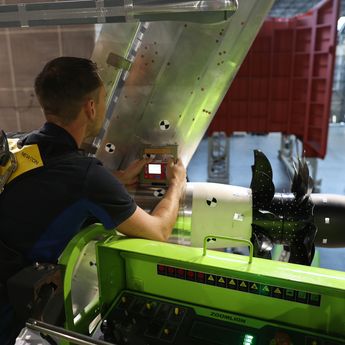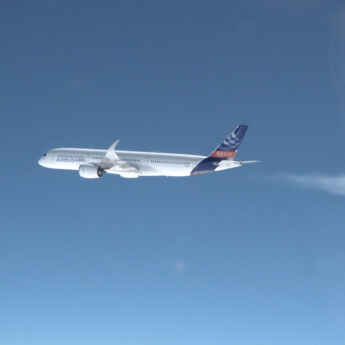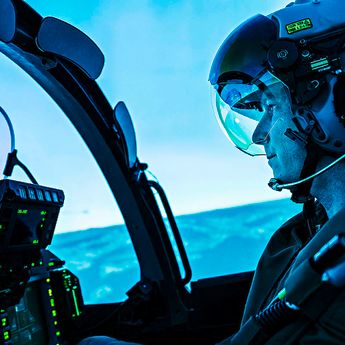Scientists and aviation leaders including Airbus are studying how to reduce aircraft non-CO₂ emissions. Options include operational contrail avoidance, sustainable aviation fuels (SAF) and in the longer term, hydrogen propulsion. What are the most promising projects?
Non-CO₂ warming effects could be as significant as CO₂ in aviation’s total climate impact. However, non-CO₂ emissions aren’t yet regulated in the same way. Scientists and industry leaders including Airbus are studying ways to mitigate and reduce non-CO₂ emissions.
Discussions are heating up over whether and how to regulate non-CO₂ emissions. It is a major aviation policy debate that affects airlines, governments and climate targets, as well as air traffic management due to scheduling and capacity constraints.
What are contrails and other non-CO₂ emissions, and why do they matter?
Burning jet fuel always creates both carbon dioxide (CO₂) and non-CO₂ emissions. In certain conditions, water vapour and some non-CO₂ emissions such as soot or other particulate matters combine to form condensation trails. Commonly known as contrails, these are the white streaks visible behind aircraft at altitude.
On average, contrails heat the atmosphere, contributing to global warming. However, some contrails can have a cooling effect, depending on when and where they form and how long they last. It’s thought that a relatively small number of flights create the majority of warming contrails.
The overall climate impact of non-CO₂ emissions is complex and hard to measure. Scientists are still working to fully understand their long-term effects.

What is the aviation industry doing about contrails and other non-CO₂ emissions?
There are three principal ways to mitigate and reduce non-CO₂ emissions. They are using different fuel types (SAF, hydrogen), propulsion technologies and operational mitigation. The latter involves modifying flight paths in real time to avoid areas where warming contrails are most likely to form.
Airbus is working with scientists, policymakers and the wider aviation industry on some 20 projects linked to these mitigation concepts. Some are funded externally while others are funded internally or with specific partners willing to share the cost of the project with Airbus.
- The projects fall into three broad categories:
Studying contrails and testing fuel alternatives, including sustainable aviation fuels and hydrogen. Projects include PACIFIC and CRYSTAL, which were announced at the Airbus Summit 2025. Both continue Airbus’ research into fuel compositions using A350 and A220 aircraft. - Operational avoidance: Exploring optimisation of flight paths to minimise persistent contrails. Live projects include CICONIA, which focuses on forecasting contrail-prone weather, climate impact modelling, and on defining the best concept of operations. CICONIA's early results indicate that, assuming appropriate procedures are put in place, operational mitigation could be applied to many flights, thus effectively reducing their contrails impact, and without significant air traffic disturbance.
- New technologies: Investing in hydrogen-powered flight and innovative propulsion systems. Live projects include Blue Condor, whose flight test results are due in late 2025. Blue Condor is a joint project between Airbus and the German Aerospace Centre DLR. Of the seven test flights, four resulted in the formation of contrails from the hydrogen engine. The aim of the investigations was to compare their microphysical properties with those of conventional contrails.

Promising technologies including humidity sensors could help aircraft to avoid weather conditions favourable to contrail formation. Humidity sensors feed weather forecasting models, so flights can benefit from improved forecasts of conditions favourable to contrail formation. Yet like climate impact models, they are in their infancy.
Nonetheless, the projects and collaborations led by Airbus and its partners are helping to accelerate the development of mitigation strategies for non-CO2 emissions and subsequent integration into flight operations.
Non-CO₂ emissions were the subject of a lively panel discussion at the Airbus Summit 2025. Watch the four-way debate here.
Discover more Innovation news
Continue Reading

Web Story Innovation
Testing the open fan’s promise
The open fan combines the fuel economy of a turboprop with the performance of a turbofan. It has the potential to significantly boost the fuel efficiency of a next generation aircraft.
Web Story Innovation
Digital Twins: Accelerating aerospace innovation from design to operations

Web Story Innovation
How to mitigate contrails and other non-CO₂ emissions

Web Story Innovation
Improving the world we live in with AI-powered products

Web Story Defence
Airbus and European innovation - Imagining a future combat aircraft cockpit

